Living Green in the Desert Garden

Community Center landscape which I was honored to have designed along with renown landscape architect, Carl Johnson.
This past weekend, I participated in a landscape discussion panel as part of a “Living Green in the Desert” seminar. Attendees were able to submit their questions ahead of time as well as ask their questions directly to us.
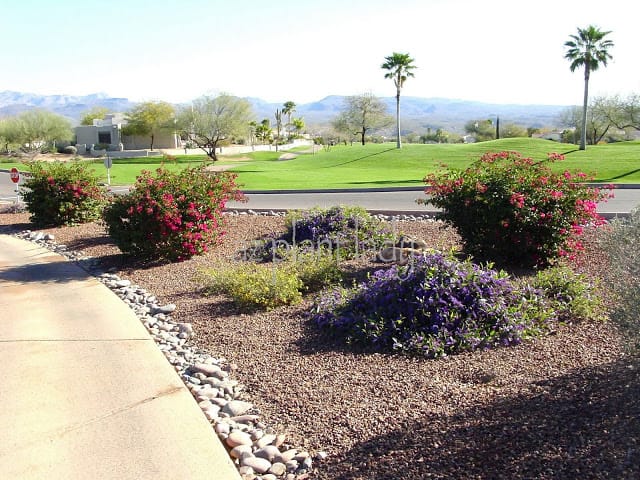
Golf Course Feature Area with Bougainvillea, Gold Lantana and Purple Lilac Vine grown as a groundcover (2002).
I was looking forward to being a part of this seminar because I had worked in this community for over 5 years as a horticulturist. So I arrived early and drove around the community and golf course areas looking at the areas that I had designed and planted over 7 years ago.
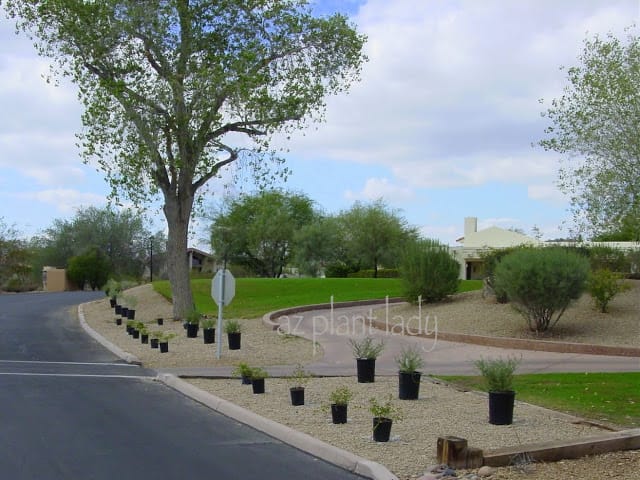
Plants that I had set out ready for the crew to come and plant (2005).
I look at the landscape areas as old friends. Of course, as living things often do, many had changed. Some areas had matured and the small plants that I had set out had matured into beautiful specimen plants. Other areas looked a little bare since flowering perennials had not been replaced, but the areas were well-maintained.
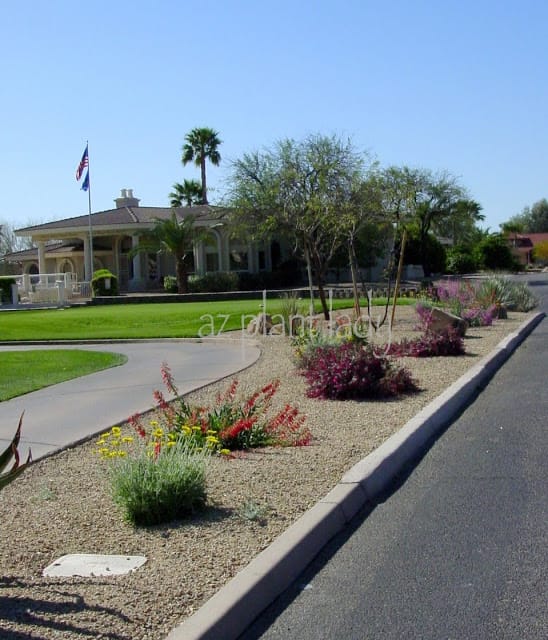
Desert Marigold, Firecracker Penstemon, Eremophila Valentine and Desert Spoon were planted in this feature area (2002).
There were 3 of us on the desert landscape panel. Although I knew one of the other participants, I always enjoy the instant camaraderie that occurs between fellow landscape professionals.
We had three different landscape sessions and the focus was on ‘living green’ in the desert landscape but all gardening questions were welcomed.
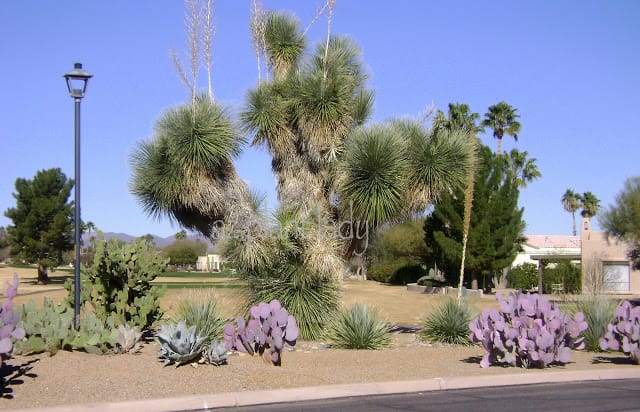
This feature area consists of only succulents such as Soaptree Yucca, Purple Prickly Pear, Desert Spoon, Opuntia robusta, Agave colorata among others. There is no regular irrigation in this area. We hand-watered the cactus monthly during the first two summers until they were established.
There were some excellent questions, and I will highlight the most popular ones.
Question #1- When and how do we prune our shrubs. Are they supposed to look like ‘balls’?
There is an epidemic in the Arizona desert where desert shrubs are pruned into round ball shapes, or as we in the landscape industry refer to as “poodle or cupcake” pruning. Those of you who have been reading my blog for awhile have seen me get up on my “high-horse” more then once, and rail against this practice. I will not repeat myself here, but you can read my previous post where I dealt with this unfortunate practice – Shrubs Aren’t Meant To Be Cupcakes.
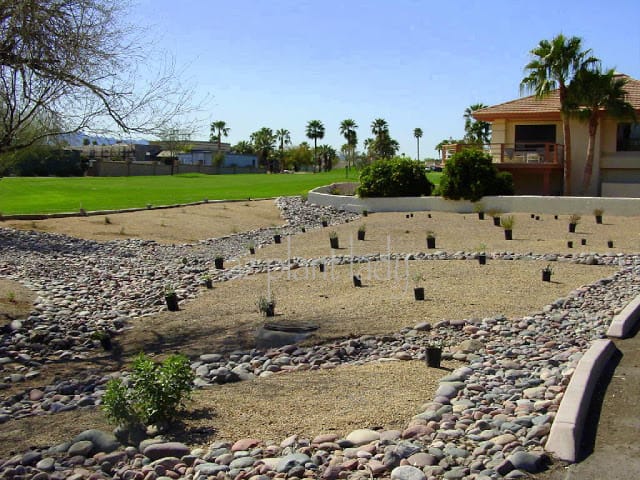
This was my favorite part of my job; designing new landscapes and seeing it all come together. Although the plants are very small when first planted, they grow very quickly in our climate.
Question #2 – When should I fertilize my plants?
Actually, most of your arid-adapted plants do not need to be fertilized. I only fertilize my plants if they show signs of a nutrient deficiency. We do fertilize our container plantings and fruit trees. Compost can be applied to all plants as this ‘feeds’ the soil.
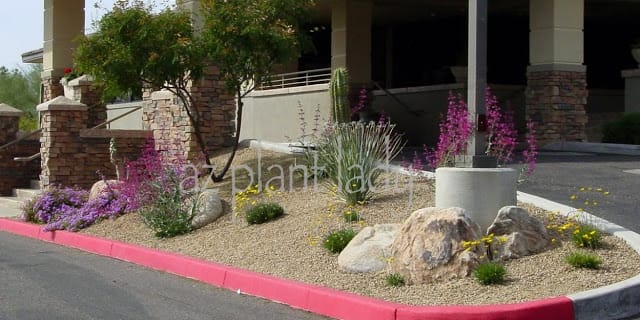
Purple Trailing Lantana, Mexican Bird-of-Paradise, Parry’s Penstemon, Desert Spoon and Angelita Daisy brighten the entrance to the clubhouse (2005).
Question #3 – Is it possible to have plants in my landscape that do not require any water?
The answer is yes you can if you use native plants. But, you will have to water them until they become established. Keep in mind that all native plants will look much better when watered periodically. That is what is done to the plants at the Desert Botanical Garden.
For excellent guidelines as to how long and often you should water your plants, please check out this excellent site, which has information about irrigating your plants in the Arizona desert, including a schedule you can put in your irrigation controller – Landscape Watering Guide
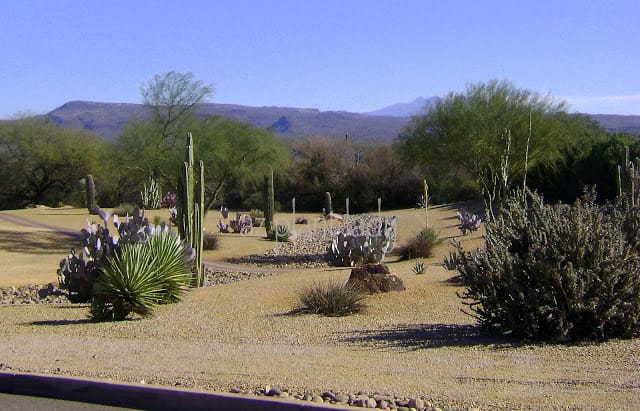
The native plants were watered in this area monthly until they were established. Periodic water was supplied during the summer months (2005).
Question #4 – Is it possible to have a winter landscape with flowering plants?
The answer is absolutely! Many residents of this community are winter visitors and are away in the summer when most plants are flowering. You can read more in a previous post of what types of plants flower during the winter months – Colorless Winter Garden…No Way!
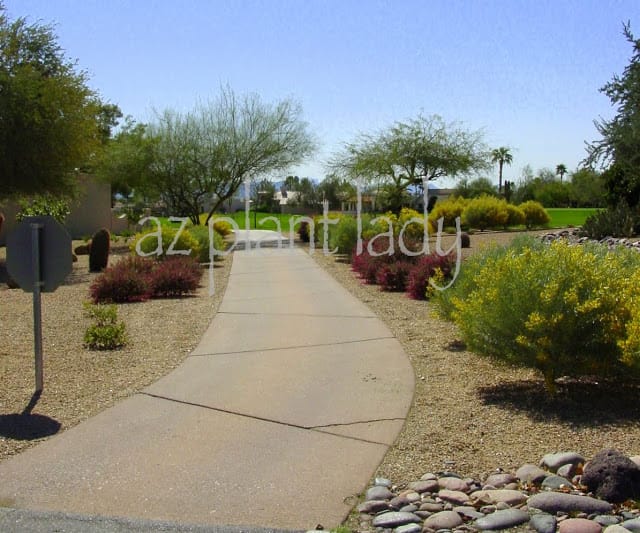
This area was planted with Eremophila Valentine and Cassia shrubs.
Question #5 – How often do I need to water my citrus trees? They are currently being watered twice a week.
When I am asked to consult with a homeowner regarding their landscape, over 90% are watering their citrus too frequently and not deeply enough. For example, in the winter months, citrus trees should only be watered once every 3 – 4 weeks. Many were shocked. I will cover citrus irrigation in more detail in the future, but there is excellent information which can be found here – Citrus Irrigation Guidelines.
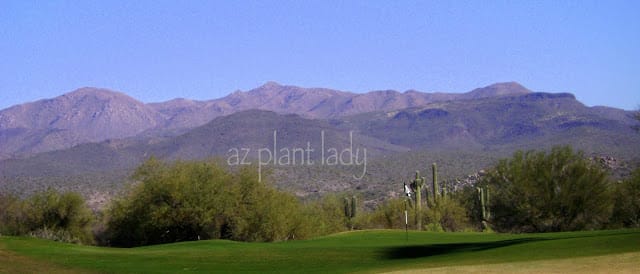
One of my favorite views from the golf course.
I had a wonderful day and enjoyed seeing old friends and meeting new ones. I was able to spend the day doing one of my most favorite things – help people learn how easy it is to have a beautiful, low-maintenance garden in the desert using plants that thrive in our climate.
Gardening in the desert is not difficult, it is just different….

 Noelle Johnson, aka, 'AZ Plant Lady' is a author, horticulturist, and landscape consultant who helps people learn how to create, grow, and maintain beautiful desert gardens that thrive in a hot, dry climate. She does this through her consulting services, her online class Desert Gardening 101, and her monthly membership club, Through the Garden Gate. As she likes to tell desert-dwellers, "Gardening in the desert isn't hard, but it is different."
Noelle Johnson, aka, 'AZ Plant Lady' is a author, horticulturist, and landscape consultant who helps people learn how to create, grow, and maintain beautiful desert gardens that thrive in a hot, dry climate. She does this through her consulting services, her online class Desert Gardening 101, and her monthly membership club, Through the Garden Gate. As she likes to tell desert-dwellers, "Gardening in the desert isn't hard, but it is different."
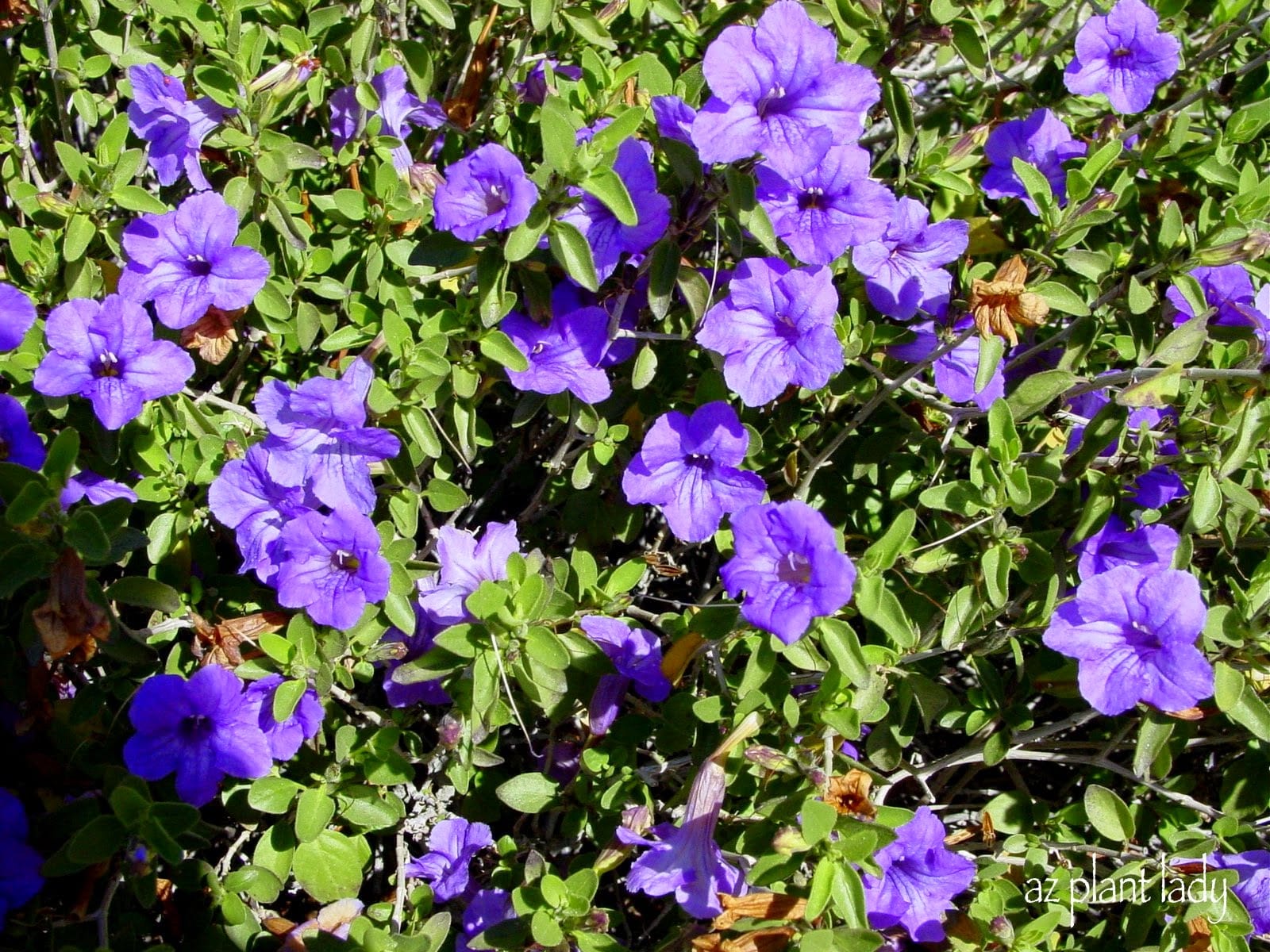

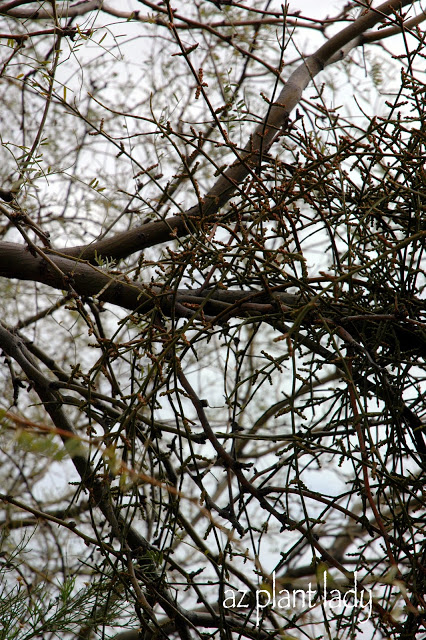












Hi Noelle Sounds as though you had a lovely time and the test of a good design ios to be able to go back 7 years later and it still hold good.
The questions and answers were interesting for us to share as well as the photos.
Those shrubs really filled out! The community is lucky to have a resource like you and I'm sure people's poor over-watered citrus trees are thanking you for advising/educating their owners, too. Love all the pictures. So often I forget to snap the before pics until it's half-way after….
Christine in Alaska
What a great seminar and such lovely gardens. I am in awe of the landscaping you designed. It is so different from what we have that it is something I couldn't imagine. I really like it.
They were lucky to have you on the board and you have every right to be proud of those great landscapes. I guess it would be like seeing a baby grow into maturity-a pride and joy no doubt.
Gorgeous! These are such lovely photos as always! Stunning! Great info too..you are awesome! Great post!
Wonderful landscapes. I love the use of the natives in that thirsty climate. The Purple Prickly Pear is outstanding!
Great post, Noelle! Your designs look wonderful and it must be satisfying to see them well cared for after the work you put into getting them established. Even here where the rainfall is much high, normally, newly planteds need a little extra help to get their roots settled in for the first year at least. The seminar sounds like fun.
Frances
Tx for those links. How useful to know how much and how often to water which plants!
Thanks for spreading the word on low water gardens! Isn't it funny that we suffer from drought, but most plant ailments in our areas are from receiving too much water? Sounds like a lot of folks got some great advice.
It was fun to see some of the landscapes you've designed and how they look now. Sounds like it was a very interesting talk with lots of good questions.
Hi Noelle…. I really like the curvy elements in the garden…. refreshing and very creative. ~bangchik
Hi Noelle,
you are such a pro. What a wonderful wealth of knowledge you have for desert gardeners. I am almost tempted to move down there.
Rosey
So interesting and the photos are just gorgeous. You live in a beautiful part of the country Noelle. I'm sure I would have to completely revise everything I know about gardening if I moved there. You did a wonderful job landscaping the golf course area. It looks excellent. lol on shrubs are not supposed to look like cupcakes! I see "balls" and "cupcake" forms in Colorado too.
Noelle, the gardens you designed still look wonderful now. I love the beautiful well manicured lawn intermixed with shrubs and flowering plants. I used to imagine desert gardens being filled with mostly cactuses only!
I think it's great how active you are in your community. And how your relationships with your landscaped gardens around town are still intact. That's very cool.
I remember seeing those green trees in your first photo, and was quite curious what they were. Green bark is not something you see here!
Noelle
I love all the colours and the strong architectural look of the plants that you used in your plans for this area. The different sizes of gravel and cobbles set the planting off so well.
Rosie 🙂
I've been amazed when I've visited the Phoenix area how all these lovely flowering plants can survive in the desert. Obviously, it takes some experience to learn the proper methods of irrigation to get them to thrive. Your designs are beautiful, Noelle, and it must give you such a sense of satisfaction to drive by something you have created and see it looking so lovely. The "cupcake" shrubs, though, are something we see here in the Midwest, too:)
I love how you incorporate the beautiful flowers and plants with the desert landscape and grass or sod. So many times people think of Arizona landscape and just think of rocks and cacti, but you really can do a lot. I've balanced both sod and desert landscape at my house, and love it.